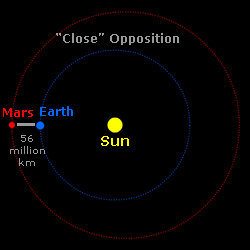Click on image for full size
Image courtesy NASA/SOHO.
Space weather storms from the Sun
News story originally written on October 24, 2003
Two gigantic sunspot groups have recently appeared on the Sun and are generating
tremendous space weather storms. The sunspot groups (known as group 484 and
group 486) are about as large as the planet Jupiter. It is very unusual for
two sunspot groups this large to appear on the Sun at the same time. Sunspots,
which are the visible manifestations of regions where strong magnetic
fields reach the surface of the Sun, are often indicators of high levels of solar
activity. These two large groups have generated powerful solar
flares and Coronal
Mass Ejections (CMEs).
A CME generated by group 484 reached Earth on Friday, 24 October 2003, bombarding
our planet with radiation and energetic protons and electrons. Such "space
weather storms" produce spectacular displays of aurora and can damage
satellites,
disrupt electrical power distribution grids, and interfere
with radio communications.
These two large sunspot groups may continue to hurl such storms towards Earth
for the next couple of weeks.
You might also be interested in:

"Without warning, the relatively calm solar atmosphere can be torn asunder by sudden outbursts of a scale unknown on Earth. Catastrophic events of incredible energy...stretch up to halfway across the visible
...more
Astronomers have discovered a dozen new moons of Jupiter so far in 2003. Scott Sheppard and David Jewitt of the University of Hawaii and Jan Kleyna of Cambridge University led the team of astronomers who
...more
On August 27, 2003, Earth and Mars will be closer together than they have been in thousands of years. The centers of the two planets will be 55,758,006 kilometers (34,646,418 miles) apart at 9:51 Universal
...more
Astronomers have recently discovered several more moons in our Solar System. Scott Sheppard and David Jewitt of the University of Hawaii and Jan Kleyna of Cambridge University announced the discovery of
...more
The planet Mercury appeared to cross in front of the disk of the Sun on May 7, 2003. Astronomers call the event a transit. A transit is similar to a solar eclipse. However, a transit occurs when a planet,
...more
Two gigantic sunspot groups have recently appeared on the Sun and are generating tremendous space weather storms. The sunspot groups (known as group 484 and group 486) are about as large as the planet
...more
Astronomers have identified another exoplanet, that is, a planet outside our solar system. This makes a total of 102 exoplanets that have so far been found by astronomers! The astronomers that identified
...more
Thanks to a couple of telescopes, everyone on the internet can browse through almost 2 million images. Stars throughout the sky were photographed by the Two-Micron All Sky Survey (2MASS) and are now available
...more














